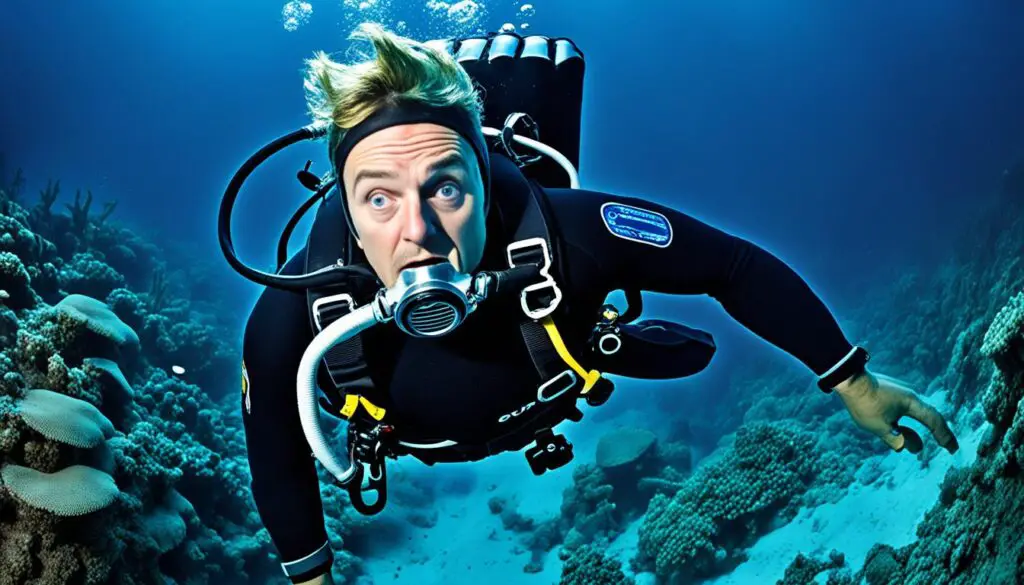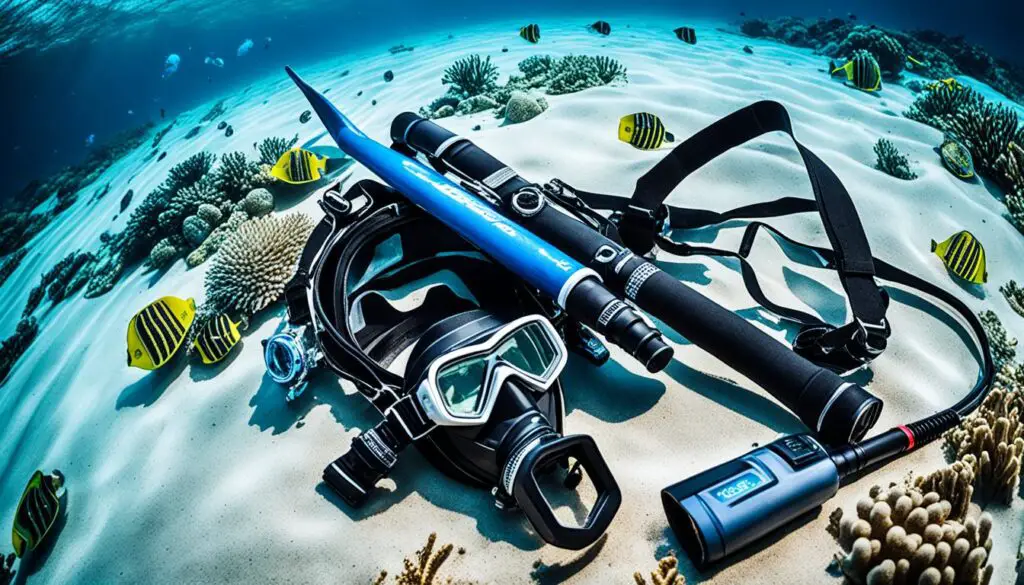Dive profiles are key for all scuba divers to learn about and use well. They help you dive better and have more fun underwater. Knowing how to do safety stops and handle decompression is important. This keeps you safe from getting sick while coming back up. In this article, we’ll show you how to make the most of dive profiles.
Key Takeaways:
- Understanding dive profiles is crucial for safety and enjoying your dive.
- Dive profiles teach you about safety stops and how to avoid getting sick.
- They help you come up to the surface without risks of getting ill.
- Using dive computers and being careful makes your dive profiles better and safer.
- Choosing the right dive gear helps make dive profiles work well.
Understanding Dive Profiles and Their Importance
Dive profiles are key in scuba diving. They outline how divers go up and down when diving. They help with decompression stress and make sure surfacing is safe. Divers think about many things to lower decompression sickness risk.
The dive computer is a handy device. It shows data like depth and time while diving. But, it might not consider every risk of decompression sickness.
Divers should be careful. They need to plan going under and coming up wisely. This means less risk of getting decompression sickness. It makes diving safer.
Knowing about decompression risk is very important. Divers should learn to keep themselves safe. They must think smartly, even if the dive computer cannot show all risks.
Being safety-first is crucial in dive planning. Following safe rules and staying informed keeps divers from decompression illness. Today’s knowledge in decompression planning helps divers be safer.
By using these tips, dive profiles become safer. Divers can love the ocean without worrying too much about decompression sickness.

Conservative Practices for Dive Profile Planning
Being cautious in dive profile planning is important. It helps avoid decompression sickness. Here’s how to plan wisely:
- Start with a safe dive plan, even if the dive might be deep or long.
- Include safety stops in your plan, even without the computer saying so.
- Don’t ascend too quickly to lower decompression stress risk.
- Go up slowly, like dive agencies advise.
- Give yourself enough break time between dives to get rid of excess nitrogen.
- Think about your own health and diving experience when making a plan.
Following these tips greatly lowers the risk of decompression sickness from your dive plan.
| Factors Influencing Decompression Risk | Considerations for Dive Profiles |
|---|---|
| Depth and bottom time | Plan conservative ascent rates and include safety stops. |
| Dive history and previous dives | Consider previous dives and adjust plans as needed. |
| Fitness level and overall health | Personal fitness and health impact dive plans for safe surfacing. |
| Environmental conditions | Changes in conditions like water temperature affect your dive profile. |
Knowing about dive profiles’ role in preventing decompression stress is crucial. Safety must come first. Divers should care for their own health and make smart choices. This leads to a better and safer diving adventure.
Essential Dive Gear for Dive Profiles
The right dive gear is key for dive profiles. Let’s look at what you need:
- Dive Mask: It should fit well to keep water out and you comfortable.
- Snorkel: Useful for breathing on the surface and saving air during dives.
- Fins: These help you swim and stay where you want underwater.
- Wetsuit: Keeps you warm and can make you float or sink as needed.
- Buoyancy Control Device (BCD): Lets you change how you float underwater.
- Regulator: It connects your air tank to your mouth for breathing.
- Weight Belt: Needed to help you stay at the right depth.
- Dive Computer: Crucial for tracking your dive, coming up safely, and knowing when to stop on the way up.

Dive Gear Essentials
| Dive Gear | Function |
|---|---|
| Dive Mask | Ensures comfort and prevents leaks |
| Snorkel | Allows for surface breathing and air conservation |
| Fins | Aids in underwater movement and position adjustment |
| Wetsuit | Provides thermal protection and aids in buoyancy control |
| Buoyancy Control Device (BCD) | Enables adjustment of buoyancy underwater |
| Regulator | Connects air tank to mouthpiece and BCD for proper breathing |
| Weight Belt | Necessary for achieving proper underwater buoyancy |
| Dive Computer | Monitors dive profiles, ensures safe ascent, and calculates decompression stops |
Conclusion
Understanding and using dive profiles are key for advanced divers. By mastering dive profiles and having the right dive gear, you can boost your diving skills. You’ll also be safer during your dive and lower the risk of decompression sickness.
The right dive gear is very important. It includes a well-fitting dive mask, snorkel, and fins for easy movement. A wetsuit keeps you warm and helps you float. A BCD lets you adjust your floating level. The regulator makes sure you breathe correctly, and a weight belt helps you stay at the right depth.
A dive computer is a must for keeping track of your dive. It helps you come up safely and figure out when to stop during your ascent. Good dive gear and knowing how to use it will make you a better diver. You’ll get to see and experience the underwater world just like a pro.
FAQ
What are dive profiles and why are they important?
A dive profile is the path divers plan for going down and coming up during a dive. It’s key to handling decompression stress and ensuring safe ascent.
How can I track and monitor dive profiles?
To keep an eye on dive profiles, dive computers come in handy. But, remember, they might miss some decompression risks.
How can I mitigate the risk of decompression sickness during dive profiles?
Lowering decompression sickness risk involves playing it safe and planning your dives carefully. Always stay focused on safety, think through details, and know you’re ultimately in charge of your well-being.
What dive gear is essential for dive profiles?
For your dive profiles, you’ll need gear like a mask, snorkel, fins, wetsuit, BCD, regulator, weight belt, and a dive computer. This equipment keeps you comfortable, safe, and efficient during dives.
How can dive gear enhance my dive profiles?
The right dive gear, including a snug mask, snorkel, fins, wetsuit, BCD, regulator, weight belt, and computer, improves your dive profiles. It makes you more comfortable, helps with breathing, stays afloat, and watches over your dive stats.
